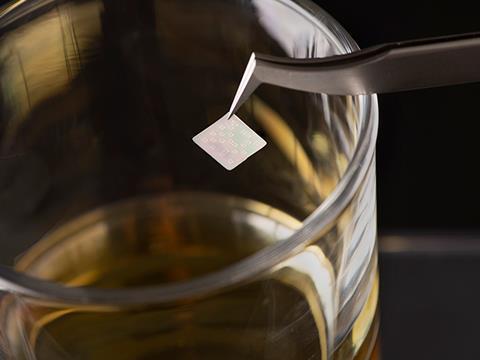
In the future, when ordering a shot of whiskey, the customer might ask the bartender to remove an edible fluorescent silk tag that could be found floating inside, even though it is safe to consume. This little silk tag, with a QR code, is a security measure that could reveal if the whiskey is fake or not.
Simply using a smartphone to scan the tag, which was developed by biomedical engineers from Purdue University and the National Institute of Agricultural Sciences in South Korea, could confirm the drink’s authenticity.
Jungwoo Leem, a postdoctoral research associate and Young Kim, both of Purdue’s Weldon School of Biomedical Engineering, are part of a global research team that has developed an edible QR code on the tag made of specialised silk which could help consumers detect fake whiskey.
There are, of course, no tags currently placed in bottles of whiskey. But this new anti-counterfeiting technology, published in the journal ACS Central Science, could be a step toward not only finding a solution for the alcohol industry but also addressing fake medications.
“Some liquid medicines contain alcohol. We wanted to test this first in whiskey because of whiskey’s higher alcohol content,” said Kim, associate head for research and an associate professor at Purdue. “Researchers apply alcohol to silk proteins to make them more durable. Because they tolerate alcohol, the shape of the tag can be maintained for a long time.”
Kim has worked on anticounterfeit measures such as cyber-physical watermarks or tags made of fluorescent silk proteins. The tags have a code activated with a smartphone to confirm the authenticity of a product.
The code on the fluorescent silk tag is the equivalent of a 2D barcode or QR code and is not visible to the naked eye. The tags are also edible, causing no issues if a person swallowed it while downing a shot of whiskey. The tags have not affected the taste of the whiskey.
Kim and Leem said making the tags involves processing fluorescent silk cocoons from specialized silkworms to create a biopolymer, which can be formed into a variety of patterns to encode the information. They placed tags in various brands and price points of whiskey over a 10-month period and were able to continually activate the tags and codes with a smartphone app.
“Alcohol spirits are vulnerable to counterfeiting. There are a lot of fake whiskeys being sold,” said Leem, referencing other studies mentioned in the journal article about the economic cost and loss of purchasing fake alcoholic spirits, including how 18% of adults in the United Kingdom experienced purchasing counterfeit alcoholic spirits.
“Online pharmacies sell controlled substances to teens. People can buy counterfeit opioids easily. This work is extremely important for patients and buyers in addressing this issue,” Kim said. “If you have this technology on or in your medicines, you can use your smartphone to authenticate. We want to empower patients to be aware of this issue. We want to work with pharmaceutical companies and alcohol producers to help them address this issue.”
Kim said the tags are an additional authentication mechanism for marked safety seals on bottles or pills and could help by being placed in high-dollar bottles of alcohol or individually on expensive medications.
This article was created in collaboration with AIPIA (the Active and Intelligent Packaging Industry Association). Packaging Europe and AIPIA are joining forces to bring news and commentary about the active and intelligent packaging landscape to a larger audience. To learn more about this partnership, click here.

















No comments yet